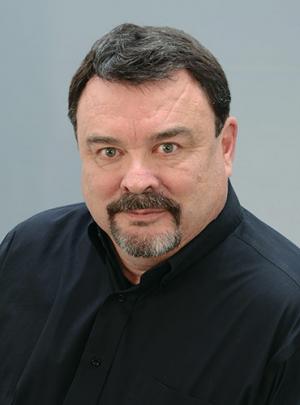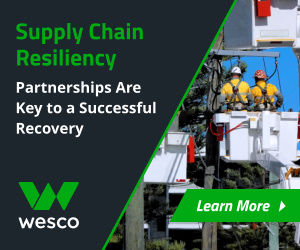AEIC
Bill Fontenot is Chair of the Association of Edison Illuminating Companies and CEO of Cleco. Steve Hauser is the CEO of AEIC.
When the historic and prestigious Association of Edison Illuminating Companies gets together for its annual meeting, as it shall in November, the industry's most senior leaders responsible for operating the country's electric systems will be in the room. Just counting those on AEIC's board of directors, there's the CEOs of American Transmission Co., Cleco, FirstEnergy, Jacksonville Electric Authority, and Orange & Rockland Utilities, the COOs of Arizona Public Service, ComEd, Eversource, Oncor, PowerSouth Energy Co-op, PPL Corp., and Tampa Electric, and several utility EVPs and SVPs. Herein we celebrate this year's AEIC Top 10 Awards for operational innovation.

PUF's Steve Mitnick: Why is the Association of Edison Illuminating Companies an important organization for our industry in the present day?
Bill Fontenot: AEIC holds a unique and important position in the industry. We are a place where the industry's leading operations experts from utilities across North America come together to share knowledge and provide guidance to the industry that is essential to achieving operational excellence in all aspects of generation, transmission, distribution, and storage of electric power.
With that said, the Edison business model that was put in place for utilities in the late 1800s and early 1900s, remains intact today through the AEIC. Utilities may get innovative in their day to day operations, but for turbines, boilers, transformers, and other equipment and technologies, we rely on OEMs, or technology providers to provide solutions.
Your modern-day Edison companies, or OEMs like GE and Siemens, all provide technology to electric utilities today. When the Edison franchisees were put in place, Edison was the technology provider to the franchisees, to Commonwealth Edison, Southern California Edison and the other Edison companies which are today's modern-day utilities. It was fitting that they would meet at least once a year at the AEIC meetings to talk about technology, and they still do so today.
 Bill Fontenot: We have access to the nation’s best operating people, and we should have a louder voice in the changes taking place in our industry. That is the AEIC leadership goal; to leverage this expertise for the benefit of our industry.
Bill Fontenot: We have access to the nation’s best operating people, and we should have a louder voice in the changes taking place in our industry. That is the AEIC leadership goal; to leverage this expertise for the benefit of our industry.
Why is it so important? Because that business model put in place over a century ago is important today to sustain the business. Though back then, they were just illuminating. Today, we're not only heating and air conditioning, as so many other essential services depend on electricity.
That business model, established more than one hundred years ago, is much the same today. In fact, the AEIC power generation committee still meets with the OEMs – the modern-day major technology providers – to give feedback and insight on their products, what's good and bad, and what's needed for the future, all with the perspective to improve the business.
At one point, I was part of the AEIC PowerGen Committee. It's very structured and still provides great feedback to the modern-day Edison companies. I'm not sure how this was done in the AEIC formative years, but it's very well done today.
Now, there's a formal survey for each technology provider, which is evaluated by the PowerGen Committee. AEIC member utility companies score each of them. The OEMs know where they stand on everything from customer service to maintenance, to emerging technology. Every technology provider also has the chance to provide insight on their products,
 Steve Hauser: AEIC is an organization that collects the expertise of people that operate the system around the country, including Canada, and identifies opportunities to make changes and improvements, develop best practices, and share those.
Steve Hauser: AEIC is an organization that collects the expertise of people that operate the system around the country, including Canada, and identifies opportunities to make changes and improvements, develop best practices, and share those.
PUF: Steve, what's your take on the importance of AEIC?
Steve Hauser: My background has been largely focused on advanced energy technology for the past several decades. Then I found myself in the last ten or so years helping to implement policy changes in Washington D.C. through the GridWise Alliance. GridWise was based on educating policymakers on the innovative technologies that were and are transforming this industry.
What I've found over the last few years is that the policymakers and CEOs have a loud voice, but the operation aspects of a utility don't have a loud voice in Washington D.C. with regard to policies, even though they're the ones largely having to implement those policy changes. I'm excited to be leading AEIC and increasing their visibility on critical issues.
AEIC is an organization that collects the expertise of the people that operate the system around the country, including Canada, and identifies opportunities to make changes and improvements, develop best practices, and share those with each other and key decision makers.
With federal legislation, technology innovations, and industry-wide initiatives focusing attention and resources on significant investments in electricity infrastructure and grid modernization, the need for and value of AEIC's technical committee work has never been greater. These transformational initiatives require AEIC's expertise and leadership to ensure investments are strategically aligned with both current and long-term grid infrastructure objectives.
My goal is to do more of that. That's the main reason that AEIC's board hired me earlier this year. They saw a vacuum in the debates that are going on nationally, and AEIC needed a bigger impact and voice in what's being debated around the country and the rapid changes taking place.
The leadership of board members like Bill and the other members of the Executive Committee, Jim Greer from Oncor and Werner Schweiger from Eversource, are critical in reaching our vision for AEIC.
PUF: Bill, it seems like the leaders want AEIC to have a more prominent role.
Bill Fontenot: There are some incredibly important committees that are part of AEIC. It began with something that looked somewhat like the PowerGen Committee but has grown to provide a lot of quality information and interaction among utilities, far more than the original Edison meetings.
Not many people know that these teams are actively working together, especially with respect to power delivery. After Hurricane Sandy, EEI and the federal government realized that our industry had many mutual exchange organizations that focused on sharing crews to help restore power during catastrophic events.
These groups were all working individually, and yet if there was a storm large enough to require more resources than a single mutual exchange organization could provide, there was not collaboration. The EEI approached AEIC to form an RMAG, or Regional Mutual Assistance Group, to work collectively to restore services across affected regions. In cases like this it's bigger than just New York or the Southeast.
Who did they look to? It was the AEIC Power Delivery Committee. Few knew what AEIC was or what it stood for. We've been this almost secret organization for decades.
However, the Power Delivery team delivered a solution that stands to support national storm restoration today. In fact, our AEIC team is launching a new mutual assistance software tool to greatly improve the sharing of work crews in recovering from a major storm.
We have access to the nation's best operating people, and we know we should have a louder voice in the changes taking place in our industry. That is the AEIC leadership goal for the future; to leverage this expertise for the benefit of our industry.
It is collaborative. Very few utilities aren't part of our organization. Whether it's cooperative, investor-owned, or public power, we have most of the industry represented.
We brought Steve in earlier this year to bring a different perspective. We don't want to disrupt what we have, but we can take it to a new level.
That's what we're challenging Steve to do, to develop a plan for how we can leverage this collaborative operating group, the best in the business, and do something better, whether it's serving EEI with more operating information, driving better public policy or improving service to the nation's customers. AEIC can do more, but that's what we're trying to figure out.
PUF: Talk about AEIC's top ten awards this year. Why is that important?
Steve Hauser: I've been impressed with the quality of projects as we went through the selection process this year. The nominations were all submitted in the spring, about the time I joined AEIC. There were sixty-three nominations from forty utility companies.
To judge all of those was a challenge, they were all good nominations, from safety practices to new technologies for supporting improved operations. Quite a variety of projects were nominated.
We decided this year to go with the top ten, because we felt like we couldn't just pick one or two. We needed to recognize the cream of the crop.
We are pleased to have PUF feature these winners in this issue. We will be giving out those awards in person at our annual meeting the first week in November in Palm Beach. We're excited about that. We're going to be looking for other ways to recognize the good work going on across the industry.
PUF: Bill, talk about those top ten awards. Why are they important?
Bill Fontenot: It's a combination of reasons including recognition of AEIC and branding. In some ways, the awards support trying to get our secret out. Receiving an award is great, but who recognized the recipient and what are their credentials?
We came up with the idea to build on the AEIC brand, but it's also to recognize those companies and their efforts to better the industry. If you've got branding and the recognition, you're getting better participation in the organization. In many ways, it was about telling more about AEIC's value and contributions to the industry.
PUF: Talk about the value of an AEIC meeting for you.
Bill Fontenot: Coming from one of the smaller utilities in the country, networking alone is a tremendous value. At Cleco, we've got a relatively small generation portfolio of about seven thousand megawatts. Yet today, through my experience with AEIC, I can grab my cell phone, and call NextEra, which is managing the largest generation fleet in the country to get advice.
You can network, whether you're the biggest or smallest utility, and you have access to the top executives in the industry. It doesn't take long to figure out that the key leaders in the industry participate in AEIC.
When Puerto Rico was destroyed by storm a few years ago, these same leaders out of the AEIC Power Delivery Committee came together. They were the first people in this nation called on to go figure out how to fix Puerto Rico's power distribution problems.
AEIC has representation from utilities that can lead the industry to the operating world, whether it's generation, transmission, or distribution, or good old-fashioned cable specifications.
PUF: Steve, what's going to be most rewarding to you?
Steve Hauser: Not surprisingly, in 2021, putting a meeting together is a challenge in the midst of a pandemic. We're doing our best to get the right people in the room. Traditionally this has been a "must attend" event for our members. The value continues to be in meeting and developing the relationships Bill mentioned, plus learning about the latest critical issues, networking, and building trust among each other.
I've been challenged to look at the brand, communication strategies, and the effectiveness of the organization in meeting our goals. We're excited to announce a few things at our annual meeting that are going to improve what AEIC looks like going forward. Stay tuned.
PUF: Bill and Steve, when asked, what do you say as to why it's good for folks to get involved and active in AEIC?
Bill Fontenot: I'd say, if you have an up and coming executive, or an operating person who's got potential, you can't ask for a better forum than AEIC. They will meet individuals in the industry, through networking. You will get to interact with the real players in this industry, understand how they're thinking, and have access to them for the future.
One of our members said it best recently when they said, our member companies send their best people to work on AEIC's committees.
Steve Hauser: There are a number of AEIC long-time participants who have been promoted up through their organizations in large part because of their involvement in AEIC. I'm sure there are other factors involved, but it seems to be an excellent training ground for leaders and managers.
They have an opportunity to provide leadership in the committee structure. They could become a vice chair or a chair, and then they come onto our board, and many have.
You've seen them over the years be involved in the committees, get on the board, and take on leadership positions within the board. I can't think of another group that provides that kind of a training ground for the industry's future leaders, at least in the operational space.
Bill Fontenot: If you just attend the meetings of AEIC in any committee, you're going to see different perspectives. You can use those perspectives to make differences in your company and your organizations going forward.
It's invaluable. The dues are more than reasonable. My question is, now, what do we do with that knowledge and expertise now that we've shared it?
We must leverage AEIC to truly make a difference in individuals, companies, growth, and knowledge transfer across the industry. With all the changes taking place in our industry, what else can we do to have a lasting impact the way AEIC has over the past century?



